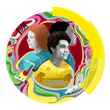Make your own sunscreen and determine its SPF using UV light transmission
This project should take approximately four to five hours to complete in full. The challenge was initially created for 14–16 year-old learners but can be adapted when teaching nanoparticles to other age groups.
Use the resource in a sequence of timetabled lessons, science clubs or during an activity day.
Learning objectives
- Describe the use of nanoparticles for a specified purpose.
- Evaluate methods for testing the effectiveness of sunscreens.
Guidance notes
The challenge links to chemistry specification statements about the nature and application of nanoparticles and includes a sequence of practical activities using sunscreen as the context for learning about nanoparticles.
Use slides 3–23 of the PowerPoint to introduce nanoparticles and their use in sunscreens.
Activity 1: preparing your sunscreen
In Activity 1, learners work in pairs to prepare their own sunscreen. Slide 26 of the PowerPoint introduces the task and full instructions are in the student workbook.
While the learners are waiting for their homemade sunscreen mixture to cool, encourage them to consider careers that may involve the skills they have been using to prepare their own sunscreen. Watch the video job profiles of Vicki, a nanotoxicologist, and Mariam, a development chemist, to provide them with more ideas.
Activity 2: estimating an SPF value for your sunscreen
Slide 29 introduces Activity 2. Learners will use four different methods to measure the sun protection factor (SPF) values of four sunscreens with known SPF values and a control. They then use these results to estimate the SPF value for their homemade sunscreen prepared in Activity 1.

This resource was developed as part of the Chemistry for All project. The project was set up to explore and address barriers to participation in UK chemistry undergraduate study through a longitudinal project. Read the findings relevant to teachers, outreach providers, education policymakers and parents in the summary report, or download the full research report.
Activity 3: presenting your findings
Learners produce a poster, guided by five questions, about the use of nanoparticles and their sunscreen activities. Slide 32 introduces the task to the learners and includes the questions they should answer while producing their poster. Download the PowerPoint slides from Presenting investigations: academic posters to provide learners with further support, including templates. You could use peer review to judge the completed presentations using the prompt: ‘How well does the poster answer the questions?’
Find suggested answers to all the activities in the teacher notes and on the slides.
As an extension to this challenge, learners could research other applications of nanotechnologies and their potential risks.
Careers
The Chemistry for All project found that recognising the value and importance of chemistry, and appreciating how it can lead to interesting and well-paid jobs strongly related to learners’ future aspirations.
Use the videos embedded in the PowerPoint to introduce learners to four scientists who use their chemistry skills, knowledge and qualifications in their careers. Share our careers website, A Future in Chemistry, with learners to discover the different study options available to them, find more job profiles of chemists making a difference and try our career options game.
More resources
- Watch the associate researcher video job profile to show learners what it’s like to work at one of the largest pharmaceutical companies in the world making the active ingredients in medicines.
- Use the Toxic socks: nanotechnology, ethics and society resource with 11–16 learners to think through the issues of nanosilver particles in socks, build a discussion and back up their opinions with facts in a debate.
- Further explore SPF and investigate how sunscreens are effective by researching and analysing with The sunshine factor project from Analytical chemistry in Ireland: a teaching and learning resource.
- Highlight other uses of nanotechnology, such as food packaging, and task your learners to create a graphic organiser to consider the advantages and disadvantages of the innovations.
Health and safety
Read our health and safety guidance and carry out a risk assessment before running any live practical. Be aware of any allergies before carrying out the activities.
The safety equipment suggested is in line with CLEAPSS requirements. For non-hazardous substances, wearing lab coats can help to protect clothes. The safety rules might be different where you live so it is worth checking local and school guidance.
In Activity 2, use low-voltage/battery-operated UV light sources in fixed housings to avoid the risk of UV light exposure causing skin or eye damage. Clamp them vertically in a stand with a cardboard roll or box lid placed to protect the learners from the UV light.
Find more projects like this, plus shorter activities suitable for single science lessons or clubs on our Outreach resources hub.
Downloads
Nanoparticles in sunscreen challenge student workbook
Editable handout | Word, Size 0.49 mbNanoparticles in sunscreen challenge student workbook
Handout | PDF, Size 0.42 mbNanoparticles in sunscreen challenge teacher notes
Editable handout | Word, Size 0.48 mbNanoparticles in sunscreen challenge teacher notes
Handout | PDF, Size 0.51 mbNanoparticles in sunscreen challenge technician notes
Editable handout | Word, Size 0.47 mbNanoparticles in sunscreen challenge technician notes
Handout | PDF, Size 0.35 mbNanoparticles in sunscreen challenge presentation slides
Presentation | PowerPoint, Size 5.29 mbNanoparticles in sunscreen challenge presentation slides
Presentation | PDF, Size 3.13 mb
Additional information
This resource was originally developed by Nottingham Trent University to support outreach work delivered as part of the Chemistry for All project.
Chemistry for All project resources
- 1
- 2
 Currently reading
Currently readingNanoparticles in sunscreen challenge
- 3
- 4
- 5
- 6





















No comments yet